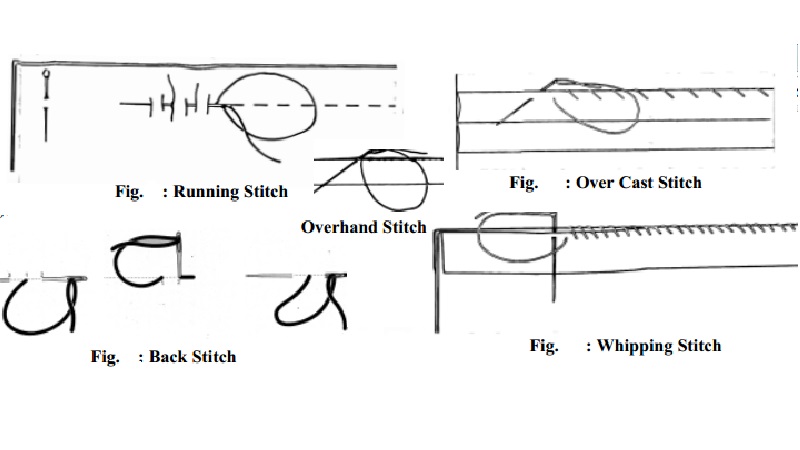Chapter: 11th 12th std standard Home Science Maintain Basic Knowledge for family life Higher secondary school College
Permanent Hand Stitches

There are
two types of sewing, hand sewing and machine sewing. The two types involve
quite different techniques. As a
beginner, hand sewing techniques can be learnt for basic sewing. To work
hand sewing quickly and perfectly, it needs practice but learning the basic
procedure helps to develop the desired skill.
The basic hand stitches can be divided into temporary stitches and
permanent stitches.
Temporary stitches are further divided into Even basting, Uneven
basting, Diagonal basting and Slip basting.
Preliminary steps to thread a needle:
1.
Cut a length of thread of about 30 inches. Do
not use a very long thread, it may knot and interrupt while sewing.
2.
Use one end to thread the needle and pull it out
from the eye of the needle.
3.
Hold two ends and tie a knot.
Permanent Hand
Stitches
Permanent hand stitches are worked instead of machine stitches. They are
permanent and serves the purpose. Permanent stitches are divided into Running
stitch, Backstitch, Overcast stitch, Over hand stitch and Whipping.
1. Running Stitch
Running
stitches are usually 1/8 inch or less in length. Work by taking several
stitches on a long needle as the fabric permits. Very fine running stitches
replace machine stitching on seams used in lingerie, blouses and infants
clothes.
2. Back Stitch
Back
Stitch resemble machine stitch on the right side, but unlike machine stitch it
overlaps on the wrong side. Take a running stitch 1/8 inch long, and reinsert
the needle at the end of the first stitch and bring it forward on the under
side and up through the surface one stitch length beyond the previous stitch.
Repeat for the next stitch. Backstitches are used to replace broken machine
stitches and also for beginning and ending of embroidery and appliqué.
3. Over Cast Stitch
Overcast
stitches are worked to keep the raw edges from fraying and may be done on
single or double edges. Hold the raw edges of the seams with the thumb and
fingers of the left hand. Insert the needle from behind the raw edge and 1/8
inch below it. Space the stitches evenly and twice as far apart as they are
deep.
4. Overhand Stitch
Overhand
stitches are similar to overcast but are made in the very edge of the fabric
and 1/16 inch apart. Insert the needle straight toward you and use a short and
very fine needle in order to pick up tiny stitches. Overhand stitches are used
to apply lace or to make flat invisible seams where two folded edges join.
5. Whipping
Whipping
is done with a single thread of matching colour. Fold the hem allowance and
work from right to left with the needle, catch one or two threads of the fabric
and one or two threads along the fold of the hem. The stitches should not be
seen on the right side of the fabric. The whipping stitch should be placed ¼
inch apart.
Related Topics